
Commander, U.S. Fleet Forces Command
Encyclopedia
Commander, U.S. Fleet Forces Command (COMFLTFORCOM), is the title of the United States Navy
officer who serves as the commanding officer
of the United States Fleet Forces Command
. The U.S. Fleet Forces Command was originally established in 1905 as the U.S. Atlantic Fleet
and as a two-star
rear admiral's billet, the position has been held by a four-star
admiral
since March 10, 1915. The 40th and current, commander of U.S. Fleet Forces Command is Admiral John C. Harvey, Jr.
The title, Commander-in-Chief, U.S. Atlantic Fleet, was continuously used from 1906 until 1923 and again from 1941 to 2002. In a reorganization of the United States Fleet
in 1923, that title was abolished and the title Commander Scouting Force was used. On February 1, 1941, General Order 143 reestablished the title and reorganized the United States Fleet into three separate fleets: the U.S. Atlantic Fleet, the U.S. Pacific Fleet
and the U.S. Asiatic Fleet
. The order further stated each fleet would be under the command of a four-star admiral. Thus, on February 1, 1941, Rear Admiral Ernest J. King, in his flagship at Culebra, Puerto Rico
, hauled down his two-star flag and hoisted his four-star flag as Commander-in-Chief, U.S. Atlantic Fleet.
After the end of World War II, the organization of the United States armed forces
was reviewed with a view toward reorganization after the turbulent war years. On December 1, 1947, under a reorganization act of the armed forces approved by Congress, the unified combatant command, United States Atlantic Command
, was established with headquarters co-located to those of the U.S. Atlantic Fleet. Admiral William H.P. Blandy was given the dual-hatted command of both U.S. Atlantic Fleet and U.S. Atlantic Command thus becoming the Commander-in-Chief, U.S. Atlantic Fleet and the first Commander-in-Chief, U.S. Atlantic Command. The two titles remained linked until another reorganization of the armed forces, via the Goldwater-Nichols Act
in 1985, separated the U.S. Atlantic Command from the U.S. Atlantic Fleet.
In the early 1950s, the North Atlantic Treaty Organization (NATO) decided to establish a new major command, Allied Command Atlantic
, under the command of a U.S. four-star admiral with headquarters in Norfolk, VA. Since this was primarily a naval command responsible for allied defense of the North Atlantic, the decision was made to co-locate this organization with that of the U.S. Atlantic Command and U.S. Atlantic Fleet, to form a tripple-hatted command. On April 10, 1952, Admiral Lynde D. McCormick
, the Commander-in-Chief, U.S. Atlantic Command and U.S. Atlantic Fleet, assumed the additional title as the first Supreme Allied Commander Atlantic
. Like the U.S. Atlantic Command, the Allied Command Atlantic remained intact and part of a tripple-hatted command organization until the Goldwater-Nichols Act occurred in 1985. The Goldwater-Nichols Act separated command of the U.S. Atlantic Fleet from the other two commands giving the U.S. Atlantic Fleet its own four-star admiral. Admiral Wesley L. McDonald
was the last U.S. Navy admiral to command all three organizations at the same time. He relinquished command of the U.S. Atlantic Fleet to Admiral Carlisle A. H. Trost
on October 4, 1985.
However, under the Goldwater-Nichols Act, the admiral filling the post of Commander-in-Chief, U.S. Atlantic Fleet, would also serve as the Deputy Commander-in-Chief, U.S. Atlantic Command. This role for CINCLANTFLT continued until 1986 when the Secretary of Defense
approved a separate billet for the Deputy Commander-in-Chief, U.S. Atlantic Command. On September 16, 1986, Admiral Frank B. Kelso II
relinquished the Deputy USCINCLANT post to Major General Thomas G. Darling, USAF.
On October 1, 2001, the Chief of Naval Operations
designated the CINCLANTFLT to concurrently serve as Commander, U.S. Fleet Forces Command
. U.S. Fleet Forces Command became responsible for overall coordination, establishment, and implementation of integrated requirements and policies for manning, equipping, and training Atlantic and Pacific Fleet units during the inter-deployment training cycle.
On October 24, 2002, Secretary of Defense Donald Rumsfeld
directed that the title of "Commander-in-Chief" be reserved solely for the President of the United States. In a message to Naval Commanders-in-Chief, the Chief of Naval Operations directed a change of title to that of "Commander." This change affected the U.S. Atlantic Fleet, U.S. Pacific Fleet, and U.S. Naval Forces Europe thus renaming Commander-in-Chief, U.S. Atlantic Fleet to Commander, U.S. Atlantic Fleet.
On May 23, 2006, the Chief of Naval Operations ordered the assimilation of U.S. Atlantic Fleet into U.S. Fleet Forces Command and that the dual-hatted position be integrated to its current title of Commander, U.S. Fleet Forces Command.
On October 31, 2006, a ceremony was held to officially mark the transition of the U.S. Atlantic Fleet and U.S. Fleet Forces Command to just U.S. Fleet Forces Command. Three of the 37 previous admirals who held the top post in the Atlantic fleet attended the ceremony, which was held aboard the aircraft carrier .
for appointment from any eligible officers holding the rank of rear admiral (lower half) or above, whom also meets the requirements for the position, under the advice and/or recommendation of the Secretary of the Navy
, the Chief of Naval Operations
, and if applicable the Chairman of the Joint Chiefs of Staff
. The nominee must be confirmed via majority vote by the Senate
.
Commander-in-Chief, U.S. Atlantic Fleet and
Commander-in-Chief, U.S. Atlantic Fleet,
Commander-in-Chief, U.S. Atlantic Fleet and
Commander-in-Chief, U.S. Atlantic Fleet and
Commander, U.S. Atlantic Fleet and
United States Navy
The United States Navy is the naval warfare service branch of the United States Armed Forces and one of the seven uniformed services of the United States. The U.S. Navy is the largest in the world; its battle fleet tonnage is greater than that of the next 13 largest navies combined. The U.S...
officer who serves as the commanding officer
Commanding officer
The commanding officer is the officer in command of a military unit. Typically, the commanding officer has ultimate authority over the unit, and is usually given wide latitude to run the unit as he sees fit, within the bounds of military law...
of the United States Fleet Forces Command
United States Fleet Forces Command
The United States Fleet Forces Command is an Atlantic Ocean theater-level component command of the United States Navy that provides naval resources that are under the operational control of the United States Northern Command...
. The U.S. Fleet Forces Command was originally established in 1905 as the U.S. Atlantic Fleet
U.S. Atlantic Fleet
The United States Fleet Forces Command is an Atlantic Ocean theater-level component command of the United States Navy that provides naval resources that are under the operational control of the United States Northern Command...
and as a two-star
2 star rank
An officer of two-star rank is a senior commander in many of the armed services holding a rank described by the NATO code of OF-7. The term is also used by some armed forces which are not NATO members...
rear admiral's billet, the position has been held by a four-star
4 star rank
Four-star rank is a term used to describe a very senior commander in many of the armed services holding a rank described by the NATO OF-9 code. The term is also used by some armed forces which are not NATO members...
admiral
Admiral (United States)
In the United States Navy, the United States Coast Guard and the United States Public Health Service Commissioned Corps, admiral is a four-star flag officer rank, with the pay grade of O-10. Admiral ranks above vice admiral and below Fleet Admiral in the Navy; the Coast Guard and the Public Health...
since March 10, 1915. The 40th and current, commander of U.S. Fleet Forces Command is Admiral John C. Harvey, Jr.
John C. Harvey, Jr.
John Collins Harvey, Jr. is a United States Navy four-star admiral who serves as the 40th and current Commander, U.S. Fleet Forces Command. He previously served as Director, Navy Staff from March 24, 2008 to July 23, 2009...
Title's history
The first Commander-in-Chief of the Atlantic Fleet was Rear Admiral Robley D. Evans, who assumed command on January 1, 1906 aboard his flagship the battleship .The title, Commander-in-Chief, U.S. Atlantic Fleet, was continuously used from 1906 until 1923 and again from 1941 to 2002. In a reorganization of the United States Fleet
United States Fleet
The United States Fleet was an organization in the United States Navy from 1922 until after World War II. The abbreviation CINCUS, pronounced "sink us", was used for Commander-in-Chief, United States Fleet. This title was disposed of and officially replaced by COMINCH in December 1941 . This...
in 1923, that title was abolished and the title Commander Scouting Force was used. On February 1, 1941, General Order 143 reestablished the title and reorganized the United States Fleet into three separate fleets: the U.S. Atlantic Fleet, the U.S. Pacific Fleet
United States Pacific Fleet
The United States Pacific Fleet is a Pacific Ocean theater-level component command of the United States Navy that provides naval resources under the operational control of the United States Pacific Command. Its home port is at Pearl Harbor Naval Base, Hawaii. It is commanded by Admiral Patrick M...
and the U.S. Asiatic Fleet
United States Asiatic Fleet
The United States Asiatic Fleet was part of the U.S. Navy. Preceding the World War II era, until 1942, the fleet protected the Philippines.Originally the Asiatic Squadron, it was upgraded to fleet status in 1902. In 1907, the fleet became the First Squadron of the Pacific Fleet. However, on 28...
. The order further stated each fleet would be under the command of a four-star admiral. Thus, on February 1, 1941, Rear Admiral Ernest J. King, in his flagship at Culebra, Puerto Rico
Culebra, Puerto Rico
Isla Culebra is an island-municipality of Puerto Rico originally called Isla Pasaje and Isla de San Ildefonso. It is located approximately east of the Puerto Rican mainland, west of St. Thomas and north of Vieques. Culebra is spread over 5 wards and Culebra Pueblo...
, hauled down his two-star flag and hoisted his four-star flag as Commander-in-Chief, U.S. Atlantic Fleet.
After the end of World War II, the organization of the United States armed forces
United States armed forces
The United States Armed Forces are the military forces of the United States. They consist of the Army, Navy, Marine Corps, Air Force, and Coast Guard.The United States has a strong tradition of civilian control of the military...
was reviewed with a view toward reorganization after the turbulent war years. On December 1, 1947, under a reorganization act of the armed forces approved by Congress, the unified combatant command, United States Atlantic Command
United States Atlantic Command
United States Atlantic Command was a Unified Combatant Command of the United States Department of Defense. In 1999, U.S. Atlantic Command was renamed and given a new mission as United States Joint Forces Command.-History:USLANTCOM was active from the 1947 to 1993 as a primarily U.S...
, was established with headquarters co-located to those of the U.S. Atlantic Fleet. Admiral William H.P. Blandy was given the dual-hatted command of both U.S. Atlantic Fleet and U.S. Atlantic Command thus becoming the Commander-in-Chief, U.S. Atlantic Fleet and the first Commander-in-Chief, U.S. Atlantic Command. The two titles remained linked until another reorganization of the armed forces, via the Goldwater-Nichols Act
Goldwater-Nichols Act
The Goldwater-Nichols Department of Defense Reorganization Act of 1986 , , made the most sweeping changes to the United States Department of Defense since the department was established in the National Security Act of 1947 by reworking the command structure of the United States military...
in 1985, separated the U.S. Atlantic Command from the U.S. Atlantic Fleet.
In the early 1950s, the North Atlantic Treaty Organization (NATO) decided to establish a new major command, Allied Command Atlantic
Supreme Allied Commander Atlantic
The Supreme Allied Commander Atlantic was one of two supreme commanders of the North Atlantic Treaty Organisation , the other being the Supreme Allied Commander Europe . The SACLANT led Allied Command Atlantic, based at Norfolk, Virginia...
, under the command of a U.S. four-star admiral with headquarters in Norfolk, VA. Since this was primarily a naval command responsible for allied defense of the North Atlantic, the decision was made to co-locate this organization with that of the U.S. Atlantic Command and U.S. Atlantic Fleet, to form a tripple-hatted command. On April 10, 1952, Admiral Lynde D. McCormick
Lynde D. McCormick
Admiral Lynde Dupuy McCormick was a four-star admiral in the United States Navy who served as vice chief of naval operations from 1950 to 1951 and as commander in chief of the United States Atlantic Fleet from 1951 to 1954, and was the first supreme allied commander of all NATO forces in the...
, the Commander-in-Chief, U.S. Atlantic Command and U.S. Atlantic Fleet, assumed the additional title as the first Supreme Allied Commander Atlantic
Supreme Allied Commander Atlantic
The Supreme Allied Commander Atlantic was one of two supreme commanders of the North Atlantic Treaty Organisation , the other being the Supreme Allied Commander Europe . The SACLANT led Allied Command Atlantic, based at Norfolk, Virginia...
. Like the U.S. Atlantic Command, the Allied Command Atlantic remained intact and part of a tripple-hatted command organization until the Goldwater-Nichols Act occurred in 1985. The Goldwater-Nichols Act separated command of the U.S. Atlantic Fleet from the other two commands giving the U.S. Atlantic Fleet its own four-star admiral. Admiral Wesley L. McDonald
Wesley L. McDonald
Wesley L. McDonald was a United States Navy four-star admiral and naval aviator. He led the first air strike against North Vietnam after the Gulf of Tonkin incident and was the commander in charge of Operation Urgent Fury, the invasion of Grenada to rescue U.S. citizens...
was the last U.S. Navy admiral to command all three organizations at the same time. He relinquished command of the U.S. Atlantic Fleet to Admiral Carlisle A. H. Trost
Carlisle Trost
Admiral Carlisle Albert Herman Trost, USN is a retired United States Navy officer who served as the Navy's twenty-third Chief of Naval Operations and a member of the Joint Chiefs of Staff from 1 July 1986 to 29 June 1990. He oversaw the Navy during the end of the Cold War, and the preparations...
on October 4, 1985.
However, under the Goldwater-Nichols Act, the admiral filling the post of Commander-in-Chief, U.S. Atlantic Fleet, would also serve as the Deputy Commander-in-Chief, U.S. Atlantic Command. This role for CINCLANTFLT continued until 1986 when the Secretary of Defense
United States Secretary of Defense
The Secretary of Defense is the head and chief executive officer of the Department of Defense of the United States of America. This position corresponds to what is generally known as a Defense Minister in other countries...
approved a separate billet for the Deputy Commander-in-Chief, U.S. Atlantic Command. On September 16, 1986, Admiral Frank B. Kelso II
Frank B. Kelso II
Frank Benton Kelso II is a retired admiral of the United States Navy, who served as Chief of Naval Operations in the early 1990s.-Early life:...
relinquished the Deputy USCINCLANT post to Major General Thomas G. Darling, USAF.
On October 1, 2001, the Chief of Naval Operations
Chief of Naval Operations
The Chief of Naval Operations is a statutory office held by a four-star admiral in the United States Navy, and is the most senior uniformed officer assigned to serve in the Department of the Navy. The office is a military adviser and deputy to the Secretary of the Navy...
designated the CINCLANTFLT to concurrently serve as Commander, U.S. Fleet Forces Command
United States Fleet Forces Command
The United States Fleet Forces Command is an Atlantic Ocean theater-level component command of the United States Navy that provides naval resources that are under the operational control of the United States Northern Command...
. U.S. Fleet Forces Command became responsible for overall coordination, establishment, and implementation of integrated requirements and policies for manning, equipping, and training Atlantic and Pacific Fleet units during the inter-deployment training cycle.
On October 24, 2002, Secretary of Defense Donald Rumsfeld
Donald Rumsfeld
Donald Henry Rumsfeld is an American politician and businessman. Rumsfeld served as the 13th Secretary of Defense from 1975 to 1977 under President Gerald Ford, and as the 21st Secretary of Defense from 2001 to 2006 under President George W. Bush. He is both the youngest and the oldest person to...
directed that the title of "Commander-in-Chief" be reserved solely for the President of the United States. In a message to Naval Commanders-in-Chief, the Chief of Naval Operations directed a change of title to that of "Commander." This change affected the U.S. Atlantic Fleet, U.S. Pacific Fleet, and U.S. Naval Forces Europe thus renaming Commander-in-Chief, U.S. Atlantic Fleet to Commander, U.S. Atlantic Fleet.
On May 23, 2006, the Chief of Naval Operations ordered the assimilation of U.S. Atlantic Fleet into U.S. Fleet Forces Command and that the dual-hatted position be integrated to its current title of Commander, U.S. Fleet Forces Command.
On October 31, 2006, a ceremony was held to officially mark the transition of the U.S. Atlantic Fleet and U.S. Fleet Forces Command to just U.S. Fleet Forces Command. Three of the 37 previous admirals who held the top post in the Atlantic fleet attended the ceremony, which was held aboard the aircraft carrier .
Appointment
The Commander, U.S. Fleet Forces Command is nominated by the PresidentPresident of the United States
The President of the United States of America is the head of state and head of government of the United States. The president leads the executive branch of the federal government and is the commander-in-chief of the United States Armed Forces....
for appointment from any eligible officers holding the rank of rear admiral (lower half) or above, whom also meets the requirements for the position, under the advice and/or recommendation of the Secretary of the Navy
United States Secretary of the Navy
The Secretary of the Navy of the United States of America is the head of the Department of the Navy, a component organization of the Department of Defense...
, the Chief of Naval Operations
Chief of Naval Operations
The Chief of Naval Operations is a statutory office held by a four-star admiral in the United States Navy, and is the most senior uniformed officer assigned to serve in the Department of the Navy. The office is a military adviser and deputy to the Secretary of the Navy...
, and if applicable the Chairman of the Joint Chiefs of Staff
Chairman of the Joint Chiefs of Staff
The Chairman of the Joint Chiefs of Staff is by law the highest ranking military officer in the United States Armed Forces, and is the principal military adviser to the President of the United States, the National Security Council, the Homeland Security Council and the Secretary of Defense...
. The nominee must be confirmed via majority vote by the Senate
United States Senate
The United States Senate is the upper house of the bicameral legislature of the United States, and together with the United States House of Representatives comprises the United States Congress. The composition and powers of the Senate are established in Article One of the U.S. Constitution. Each...
.
Commander-in-Chief, U.S. Atlantic Fleet
| # | Name | Rank | Picture | Start of tenure | End of tenure |
|---|---|---|---|---|---|
| 1 | Robley D. Evans |  |
 |
||
| 2 | Charles S. Sperry |  |
 |
||
| 3 | Seaton Schroeder Seaton Schroeder Seaton Schroeder was an admiral of the United States Navy.-Biography:Schroeder was born in Washington, D.C., on 17 August 1849 the son of Frances Schroeder, who was the United States Ambassador to Sweden... |
 |
|||
| 4 | Hugo W. Osterhaus Hugo Osterhaus Hugo Osterhaus was a Rear Admiral in the United States Navy. He was the son of Civil War Major General Peter J. Osterhaus and father of Navy Admiral Hugo Wilson Osterhaus , and is buried on Arlington National Cemetery.-U.S... |
 |
|||
| 5 | Charles J. Badger Charles J. Badger Charles Johnston Badger was an admiral in the United States Navy. His active-duty career included service in the Spanish-American War and World War I.-Biography:... |
 |
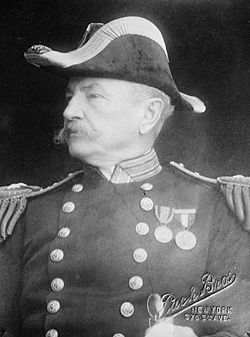 |
||
| 6 | Frank F. Fletcher |  |
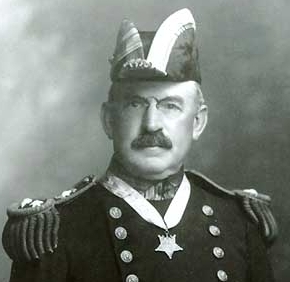 |
||
| 7 | Henry T. Mayo Henry T. Mayo Henry Thomas Mayo was an admiral of the United States Navy.Mayo was born in Burlington, Vermont, 8 December 1856. Upon graduation from the United States Naval Academy in 1876 he experienced a variety of naval duties including coastal survey... |
 |
 |
||
| 8 | Henry B. Wilson |  |
|||
| 9 | Hilary P. Jones Hilary P. Jones Hilary Pollard Jones, Jr. was an officer in the United States Navy during the Spanish-American War and World War I. During the early 1920s, he served as Commander in Chief, United States Fleet.... |
 |
|||
| 10 | Ernest J. King Ernest King Fleet Admiral Ernest Joseph King was Commander in Chief, United States Fleet and Chief of Naval Operations during World War II. As COMINCH, he directed the United States Navy's operations, planning, and administration and was a member of the Joint Chiefs of Staff. He was the U.S... |
 |
 |
||
| 11 | Royal E. Ingersoll Royal E. Ingersoll Royal Eason Ingersoll was a United States Navy four-star admiral who served as Commander in Chief, U.S. Atlantic Fleet from January 1, 1942 to late1944; Commander, Western Sea Frontier from late 1944 to 1946; and Deputy Commander in Chief, U.S... |
 |
 |
||
| 12 | Jonas H. Ingram Jonas H. Ingram Admiral Jonas Howard Ingram was an officer in the United States Navy during World War I and World War II... |
 |
|||
| 13 | Marc A. Mitscher Marc Mitscher Admiral Marc Andrew "Pete" Mitscher was an admiral in the United States Navy who served as commander of the Fast Carrier Task Force in the Pacific in the latter half of World War II.-Early life and career:... |
 |
Commander-in-Chief, U.S. Atlantic Fleet and
Commander-in-Chief, U.S. Atlantic Command
| # | Name | Rank | Picture | Start of tenure | End of tenure |
|---|---|---|---|---|---|
| 14 | William H. P. Blandy William H. P. Blandy William Henry Purnell Blandy , known to friends as "Spike", was an admiral in the United States Navy during World War II.-Biography:... |
 |
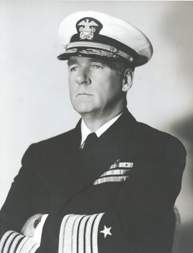 |
||
| 15 | William M. Fechteler William Fechteler William Morrow Fechteler was an admiral in the United States Navy who served as Chief of Naval Operations during the Eisenhower administration. He was the son of Rear Admiral Augustus F. Fechteler.-Biography:... |
 |
 |
Commander-in-Chief, U.S. Atlantic Fleet,
Commander-in-Chief, U.S. Atlantic Command and
Supreme Allied Commander Atlantic
| # | Name | Rank | Picture | Start of tenure | End of tenure |
|---|---|---|---|---|---|
| 16 | Lynde D. McCormick Lynde D. McCormick Admiral Lynde Dupuy McCormick was a four-star admiral in the United States Navy who served as vice chief of naval operations from 1950 to 1951 and as commander in chief of the United States Atlantic Fleet from 1951 to 1954, and was the first supreme allied commander of all NATO forces in the... |
 |
|||
| 17 | Jerauld Wright Jerauld Wright Admiral Jerauld Wright, USN, served as the Commander-in-Chief of the U.S. Atlantic Command and the Commander-in-Chief of the U.S... |
 |
|||
| 18 | Robert L. Dennison |  |
|||
| 19 | Harold P. Smith |  |
|||
| 20 | Thomas H. Moorer Thomas Hinman Moorer -External links:... |
 |
 |
||
| 21 | Ephraim P. Holmes Ephraim P. Holmes Ephraim Paul Holmes was a four-star admiral in the United States Navy who served as commander in chief of the U.S... |
 |
|||
| 22 | Charles K. Duncan Charles K. Duncan Charles Kenney Duncan was a United States Navy four star admiral who served as Supreme Allied Commander Atlantic/Commander in Chief, United States Atlantic Command/Commander in Chief, U.S. Atlantic Fleet from 1970 to 1972.-Military career:Duncan was born on December 7, 1911 in Nicholasville,... |
 |
|||
| 23 | Ralph W. Cousins Ralph W. Cousins Ralph W. Cousins was a United States Navy four star admiral and aviator. As an aircraft carrier pilot, Cousins led dive-bomber attacks against the Imperial Japanese Navy at the Battle of the Coral Sea in May 1942 for which he was awarded the Navy Cross... |
 |
|||
| 24 | Isaac C. Kidd, Jr. Isaac C. Kidd, Jr. Isaac Campbell Kidd, Jr. was an American Admiral in the United States Navy who served as the Supreme Allied Commander of NATO's Atlantic Fleet, and also as commander in chief of the U.S. Atlantic Fleet from 1975 to 1978. He was the son of Rear Admiral Isaac C... |
 |
|||
| 25 | Harry D. Train II Harry D. Train II Harry Depue Train II is a retired Admiral in the United States Navy and a Senior Fellow at the Joint Advanced Warfighting School at the Joint Forces Staff College in Norfolk, Virginia.-Naval career:... |
 |
|||
| 26 | Wesley L. McDonald Wesley L. McDonald Wesley L. McDonald was a United States Navy four-star admiral and naval aviator. He led the first air strike against North Vietnam after the Gulf of Tonkin incident and was the commander in charge of Operation Urgent Fury, the invasion of Grenada to rescue U.S. citizens... |
 |
Commander-in-Chief, U.S. Atlantic Fleet and
Deputy Commander-in-Chief, U.S. Atlantic Command
| # | Name | Rank | Picture | Start of tenure | End of tenure |
|---|---|---|---|---|---|
| 27 | Carlisle A. H. Trost Carlisle Trost Admiral Carlisle Albert Herman Trost, USN is a retired United States Navy officer who served as the Navy's twenty-third Chief of Naval Operations and a member of the Joint Chiefs of Staff from 1 July 1986 to 29 June 1990. He oversaw the Navy during the end of the Cold War, and the preparations... |
 |
 |
||
| 28 | Frank B. Kelso II Frank B. Kelso II Frank Benton Kelso II is a retired admiral of the United States Navy, who served as Chief of Naval Operations in the early 1990s.-Early life:... |
 |
 |
Commander-in-Chief, U.S. Atlantic Fleet
| # | Name | Rank | Picture | Start of tenure | End of tenure |
|---|---|---|---|---|---|
| 28 | Frank B. Kelso II Frank B. Kelso II Frank Benton Kelso II is a retired admiral of the United States Navy, who served as Chief of Naval Operations in the early 1990s.-Early life:... |
 |
 |
||
| 29 | Powell F. Carter, Jr. Powell F. Carter, Jr. Powell Frederick Carter, Jr. is a retired United States Navy four star admiral who served as Director of the Joint Staff 1985–1987, United States Military Representative, NATO Military Committee from 1987 to 1988; and as Commander in Chief, United States Atlantic Fleet from 1988 to 1991.-Notes:... |
 |
 |
||
| 30 | Paul David Miller Paul David Miller Paul David Miller is a retired Admiral in the United States Navy. His last duty in the Navy was to serve as Commander-in-Chief, of the U.S. Atlantic Command.... |
 |
|||
| 31 | Henry H. Mauz, Jr. Henry H. Mauz, Jr. Henry H. Mauz, Jr. is a retired United States Navy admiral and the former Commander in Chief, United States Atlantic Fleet from 1992 to 1994.-Military career:... |
 |
 |
||
| 32 | William J. Flanagan, Jr. |  |
|||
| 33 | J. Paul Reason J. Paul Reason Joseph Paul Reason was Commander in Chief, United States Atlantic Fleet from 1996 to 1999. Earlier in his career, as a commander, he was naval aide to the President of the United States, Jimmy Carter, from December 1976 to June 1979... |
 |
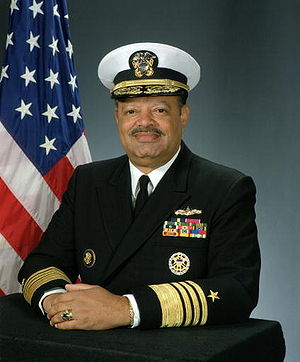 |
||
| 34 | Vern Clark Vern Clark Admiral Vernon E. Clark USN was the Chief of Naval Operations in the United States Navy. He retired 22 July 2005, making his tenure of five years the second-longest serving CNO behind Arleigh Burke. He currently sits on the board of directors of Raytheon and SRI International... |
 |
 |
||
| 35 | Robert J. Natter Robert J. Natter Admiral Robert Joseph Natter is a retired United States Navy admiral who served as Commander, U.S. Atlantic Fleet/Fleet Forces Command from 2000 to 2003.-Military career:... |
 |
Commander-in-Chief, U.S. Atlantic Fleet and
Commander, U.S. Fleet Forces Command
| # | Name | Rank | Picture | Start of tenure | End of tenure |
|---|---|---|---|---|---|
| 35 | Robert J. Natter Robert J. Natter Admiral Robert Joseph Natter is a retired United States Navy admiral who served as Commander, U.S. Atlantic Fleet/Fleet Forces Command from 2000 to 2003.-Military career:... |
 |
Commander, U.S. Atlantic Fleet and
Commander, U.S. Fleet Forces Command
| # | Name | Rank | Picture | Start of tenure | End of tenure |
|---|---|---|---|---|---|
| 35 | Robert J. Natter Robert J. Natter Admiral Robert Joseph Natter is a retired United States Navy admiral who served as Commander, U.S. Atlantic Fleet/Fleet Forces Command from 2000 to 2003.-Military career:... |
 |
|||
| 36 | William J. Fallon William J. Fallon William Joseph Fallon is a retired United States Navy four-star admiral who retired after serving for over 41 years. His last military assignment was as Commander, U.S. Central Command from March 2007 to March 2008. ADM Fallon was the first Navy officer to hold that position. His other four-star... |
 |
 |
||
| 37 | John B. Nathman John B. Nathman John B. Nathman is a retired United States Navy admiral who served as the Commander, U.S. Fleet Forces Command until 17 May 2007.-Early career:... |
 |
 |
Commander, U.S. Fleet Forces Command
| # | Name | Rank | Picture | Start of tenure | End of tenure |
|---|---|---|---|---|---|
| 37 | John B. Nathman John B. Nathman John B. Nathman is a retired United States Navy admiral who served as the Commander, U.S. Fleet Forces Command until 17 May 2007.-Early career:... |
 |
 |
||
| 38 | Gary Roughead Gary Roughead Gary Roughead is a retired United States Navy four-star admiral who last served as the 29th Chief of Naval Operations from September 29, 2007 to September 22, 2011. He previously served as Commander, U.S. Fleet Forces Command, from May 17, 2007, to September 29, 2007. Prior to that he served as... |
 |
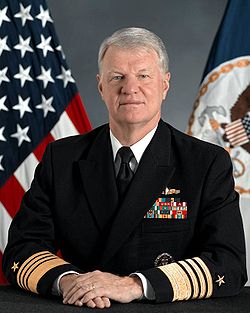 |
||
| 39 | Jonathan W. Greenert Jonathan W. Greenert Jonathan W. Greenert is a United States Navy admiral currently serving as the 30th Chief of Naval Operations. He previously served as the 36th Vice Chief of Naval Operations from August 13, 2009 to August 22, 2011. Prior to that, he served as Commander, U.S... |
 |
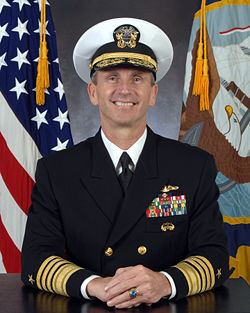 |
||
| 40 | John C. Harvey, Jr. John C. Harvey, Jr. John Collins Harvey, Jr. is a United States Navy four-star admiral who serves as the 40th and current Commander, U.S. Fleet Forces Command. He previously served as Director, Navy Staff from March 24, 2008 to July 23, 2009... |
 |
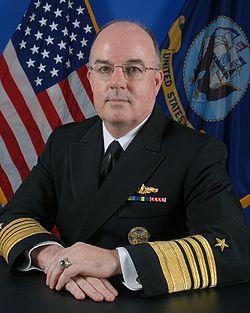 |
Incumbent |
External links
- U.S. Fleet Forces Command official website
- List of U.S. Fleet Forces Command commanders

